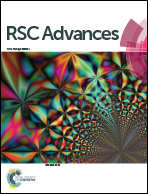Synthesis and characterization of porous fibers/polyurethane foam composites for selective removal of oils and organic solvents from water†
Abstract
In the field of oil/water separation, functional oil-absorbing materials with both controllable porous structures and swelling properties are highly desirable. In the present study, we report a novel strategy for fabricating Mg–Al porous fiber (Mg–Al PF)/polyurethane (PU) foam composites using a combined biotemplate method and foaming technology, and discuss their application in the absorption of oils and organic solvents. The Mg–Al PF composites with a hierarchical porous structure are fabricated based on nanoplatelets on the surfaces of microscale inorganic fibers. The PU foam composites with excellent oil swelling properties are synthesized by addition of Mg–Al PF composites to PU foams. In order to enhance the hydrophobic and oleophilic properties, the surfaces of Mg–Al PF composites are chemically modified using silane coupling agent (KH 570). The surface modified Mg–Al PF composites show high repellency towards water with a water contact angle of 146.6°. Owing to their unique pore structures and superhydrophobic and swelling properties, the foam composites can remove oils and organic solvents from water with high selectivity and absorption capacity, and can absorb not only floating oil but also heavy organic solvents underwater. In general, the absorption capacities of the PU foam composites for oils and organic solvents are 5.06–44.81 times their own weight, partly depending on the density and viscosity of the absorbate. The PU foam composites still maintain relatively consistent absorption properties for oil and organic solvent absorption after 10 cycles. These outstanding properties potentially make the as-prepared PU foam composites promising candidates for practical oil absorption and oil/water separation.


 Please wait while we load your content...
Please wait while we load your content...